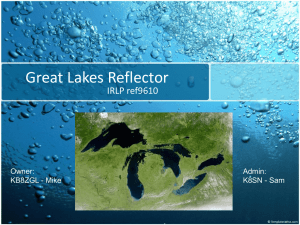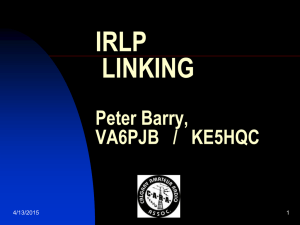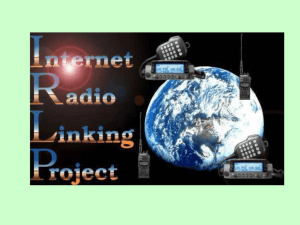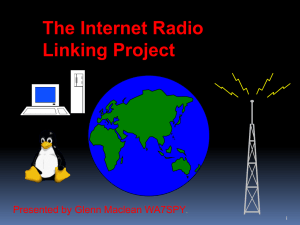Document
advertisement
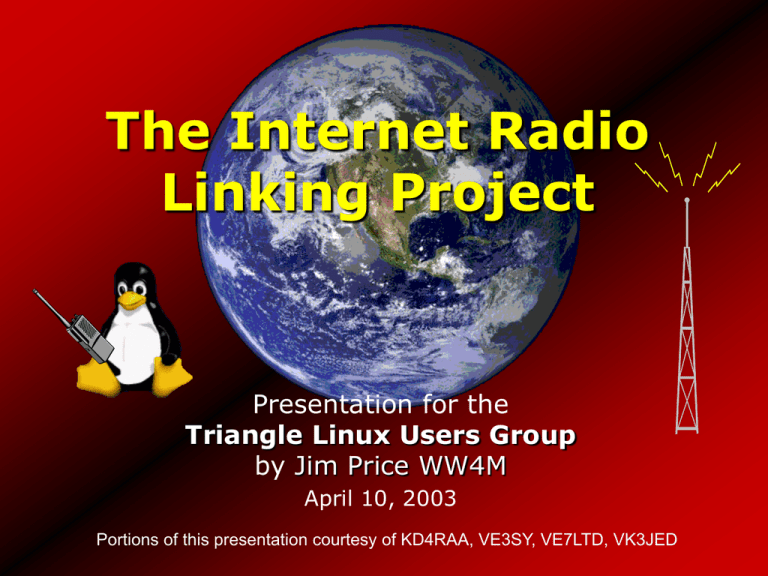
The Internet Radio Linking Project Presentation for the Triangle Linux Users Group by Jim Price WW4M April 10, 2003 Portions of this presentation courtesy of KD4RAA, VE3SY, VE7LTD, VK3JED - What is Amateur Radio? Ham Radio Activities IT and Amateur Radio Ham Radio Internet Linking The IRLP Network IRLP Hardware IRLP Software Using IRLP Listening For More Info... Demonstration Overview What is Amateur Radio? • Licensed as a public service by the Federal Communications Commission • voluntary non-commercial communications, with an emphasis on providing emergency communications • advancement of the radio art • advancing communication and technical skills and provide trained operators, technicians and electronics experts • promote international goodwill • 680,000 hams in the U.S., 18,000 in NC Celebrity Hams Entertainers: Chet Atkins WA4CZD, Ronnie Milsap WB4KCG, Marlon Brando FO5GJ, Patty Loveless KD4WUJ, Gary Shandling KD6OY, Burl Ives KA6HVA, Arthur Godfrey K4LIB, Priscilla Presley N6YOS Joe Walsh WB6ACU . A huge number of politicians and royals including: Gov. George Pataki N2ZCZ, Sen. Barry Goldwater K7UGA, Spain’s King Juan Carlos EA0JC, Jordan's King Hussein JY1 and Queen Noor JY2, Argentina’s Pres. Carlos Menem LU1SM, India’s Rajiv Gandhi VU2RG Famous and infamous hams: most astronauts, Hugh Downs KD6WUS, Art Bell W6OBB, Kevin Mitnick N6NHG, and the author of The Joy of Sex, Dr. Alex Comfort KA6UXR Walter Cronkite KB2GSD Celebrity non-Hams Forest Whitaker Phenomenon Dennis Quaid non-Celebrity Hams Amateur Radio Activities • • • • HF (shortwave) VHF/UHF and repeaters Morse code, analog voice Public Service/ Emergencies • Home-building equipment • “Dxing” (long distance contacts) • Contesting • Amateur Radio Satellites • Digital Modes TV TV IT and Amateur Radio • Computer-Controlled Modes – Packet Radio – Narrow Band Teletype (e.g. PSK-31) – Amateur Television – IEEE 802.11b WiFi / HSMM • GPS & APRS • Amateur Radio Satellites • Internet Radio Linking • Remote Bases and Web Radio • Digital Signal Processing • Software Defined Radio • Spread Spectrum Technology • Contact Logging Software • Antenna Design Computer Radio or Repeat er Mobile Station Internet Radio Link Computer Distant Radio or Repeater • Repeater: A station that simultaneously retransmits the transmission of another station over a wider area on another 441 MHz frequency down 446 MHz up Coverage from 320-ft in West Raleigh Ham Radio - Internet Linking Radio-only Access • IRLP (linux) PC -or- Radio Access: • eQSO (Windows) • iLink (Windows) • WIRES (Windows) • EchoLink (Windows or linux) The Internet Radio Linking Project (IRLP) • Uses the Internet to link distant radio sites • Gives global coverage to normally localized VHF and UHF frequencies • Enables minimally equipped stations to communicate globally • Allows end user control of links via their radio’s DTMF (Touchtone) keypad The Internet Radio Linking Project (IRLP) Created by Dave Cameron VE7LTD of Vancouver, BC Dave was frustrated with the unreliable operation of Windows-based Iphone and turned to linux. Iphone and other systems use VOX. IRLP uses COS. IRLP is radio-access only. Dave VE7LTD and Pete VK2YX IRLP Growth November 1998 - 2 December 1999 +10= 12 June 2000 +20 = 32 December 2000 +29 = 61 June 2001 +61 = 122 December 2001 + 199 = 321 June 2002 + 236 = 557 December 2002 +263 = 820 database records 1/1/03 IRLP Network 445 United States 154 Canada 54 Australia + New Zealand 49 Europe 12 Caribbean + Bermuda 6 Japan 3 Southern Africa 2 Ecuador, Mexico 1 India 1 Antarctica active nodes 4/1/03 Australia and New Zealand Europe North America Example: Los Angeles Area Nodes 3520 WB6EGR Burbank 448.480 8590 KF6PXL Corona 7380 K7QT Highland 449.840 3190 WD8CIK Hollywood 446.560 3170 WD6AWP Huntington Beach 145.140 3609 K6GTZ Lakewood 3745 KE6HRV Long Beach 144.480 3040 WA6JFK Los Angeles 1294.600 3650 KE6PCV Los Angeles 447.720 3760 N6JVH Los Angeles 447.240 3830 WB5EKU Los Angeles 447.200 3910 WB6DAO Los Angeles 447.600 5610 KF6CPI Los Angeles 224.580 8630 KE6YGM Mission Viejo 144.440 3670 N6JVH North Hills 3140 KE6DGM Norwalk 449.340 5850 KJ6W Palmdale 445.600 3030 KB6THO Pasadena 224.480 3340 WR6JPL Pasadena 224.080 7170 W6EKZ Pomona 144.440 3448 KJ6KB Rancho Palos Verdes [WALA IV] 145.725 4810 KF6FM Riverside 5900 WB9RNW San Fernando Valley 445.180 3846 WB6T San Juan Capistrano 447.540 3100 N6KNW Santa Clarita 51.860 3510 WB6EGR Santa Clarita 927.500 3410 KD6GDB Santa Monica 145.800 4690 KF6JEE Woodcrest 446.280 51.500 IRLP is based on Speak Freely for Linux. Speak Freely for linux is Open Source, while Speak Freely for Windows is GPL. Linux offered the best in reliability, programmability, efficiency, and functionality. IRLP currently ships with RH 7.3 and will run on a 486 DX100 or better computer (init=3). Typical IRLP Node • • • • Standard PC, P100 or better Linux (Red Hat 7.3) SB16 ISA soundcard Custom IRLP computer/radio control interface • Radio • Dedicated internet connection Custom Red Hat CD-ROM Boot Diskette Custom IRLP Software IRLP Control Board Does COS, PTT & DTMF DB9 IRLP to Radio Interface LPT1 to IRLP Jumper Cable v.2 IRLP card DB9 for radio inter -face +12VDC from PC DB25 for Data Control from LPT1 & IRLP Indicators on v.2 Control Board – DTMF Decode Sense – Carrier Operated Squelch Sense – PTT out to Link Radio or Controller v.3 IRLP card features surface-mount components 100MB Switch 10MB Hub Linksys Router DualBand 2M/440 Control Xcvr 4270 Link Radio 4260 Link Radio KD4RAA Node 4260 / 4270 Configuration Audio Equalizer and Broadcast Leveling What Happens During a Call? Notes from Dave Cameron, VE7LTD DTMF Decode • DTMF program monitors COS and DTMF • Once detected DTMF sequence passed to the decode script • Decode script checks custom_decode for matches • Assuming a call is decoded, call script is started with the node number as the argument VE7LTD Call Script • • • • Best server is determined by using find_best_server script Best server is asked for latest IP of node being called If IP received is different from IP in hosts file, a new hosts file is d/l from best server Irlp_call is started, and a TCP connection is made to the called node on port 15425 VE7LTD IRLP_CALL / IRLP_ANSWER • • • • Remote node starts irlp_answer in response to TCP call on port 15425 PGP security performs a dual challenge to ensure calling node is an IRLP node Codec (GSM/ADPCM) is determined Irlp_call and irlp_answer start speak freely software on UDP ports 2074 and 2075 VE7LTD During the Call • Irlp_call and irlp_answer send keepalives in the background. If keepalive fails, the connection drops (every 15 sec) • Irlp_call and irlp_answer keep open info channel to pass dtmf regeneration info, disconnect/timeout message VE7LTD Disconnects • Disconnecting node uses TCP info channel to send disconnect message. Both nodes run the off script • Unexpected drop in the TCP connection prompts reset of IRLP node • If the timeout elapses, disconnect is sent VE7LTD NCSU Bookstores: Sending Audio Audio streaming is enabled when the link radio receives a signal with COS and keys the IRLP interface card. The sound card receives the radio’s audio and creates a continuous mono 8-bit digital stream of raw audio at 8000Hz (64k bps). Speak Freely’s sfmike program compresses the audio stream by a factor of two (32k bps) using an audio compression algorithm (codec). NCSU Bookstores: The audio is split into packets, which are transmitted over port 2074 using a User Datagram Protocol (UDP) stream. UDP does NOT confirm the reception of packets it "fires and forgets" NCSU Bookstores: Receiving Audio Speak Freely’s sfspeaker receives the packets on port 2075 and rejoins them into an 8-bit ULAW stream. . Next the ULAW stream is uncompressed back into an 8-bit raw stream of audio. . The raw audio is streamed through the digital to analog (D/A) converter (the output device of your sound card). . The IRLP interface card keys the radio when the audio stream is present (live -- no buffering). NCSU Bookstores: Audio Compression ADPCM GSM Jason Woodard, http://www-mobile.ecs.soton.ac.uk/speech_codecs/ NCSU Bookstores: ADPCM (Adaptive Differential Pulse Code Modulation) • only 32 kb/s - more efficient than the PCM codec used by WAV, AIFF and CD audio (and is used on the Sony Mini Disc) • cuts the data rate from 8000 to 4000 bps • superior sound quality vs. GSM NCSU Bookstores: GSM (Global System for Mobile Communications) • requires only 13 kb/s bandwidth • reduces the data rate from 8000 to 1650 bps, which makes a 28.8 Kb modem usable • serves 71% of the total digital wireless market and provides good quality speech NCSU Bookstores: ADPCM quantizes the difference between the sampled signal and a prediction. If the prediction is accurate, the difference between the real and predicted samples will have a lower variance than the real speech samples and will be accurately quantized with fewer bits than needed for the original. At the decoder the quantized difference signal is added to the predicted signal to give the reconstructed speech signal. Performance is aided by using adaptive prediction and quantization, so that the predictor and difference quantizer adapt to the changing characteristics of the sampled speech. NCSU Bookstores: GSM uses a Regular Pulse Excited (RPE) codec. Input is split into 20ms frames, each with 8 short term predictor coeffiecients. Frames are further split into four 5ms sub-frames, each with a delay and gain for a long term predictor. After short and long term filtering, the residual signal for each sub-frame is decimated into three possible excitation sequences, each 13 samples long. The sequence with the highest energy is chosen as the best rep-resentation of the excitation sequence, and each pulse in the sequence has its amplitude quantized with three bits. At the decoder the reconstructed excitation signal is fed through the long term and short term synthesis filters to reconstruct the speech. A postfilter improves perceptual quality Ports Required 2074 - 2093 Audio (bi-directional UDP) 15425-7 IRLP Control/Update (TCP) Outbound ports used: 80 (http) for updates 873 or 8873 (rsync) for downloading updates 10000 (for IP determination) parallel port set to "standard" or "compatible" mode, not to ECP, EPP or bi-directional Some IRLP Details 512-bit bi-directional PGP authentication ensures connections only with other IRLP nodes. Redundant servers support IRLP-BIND (DHCP isn’t a problem) as well as download of pgp key rings, software updates, and station ID wavfiles. IRLP accepts commands from keyboard or via DTMF (dual tone multi frequency, i.e. “Touchtones”) IRLP and the GPL “I had released code under the GPL, and it led to nothing but 1000's of emails criticising my code, asking for features, wondering why I built this that way, etc... I got tired of answering questions.” “There is a strong commercial potential for this product, and I did not want to hand several 1000 hours worth of code to the private sector just to be replicated.” “Closed code maintains a standard, which open releases would compromise.” VE7LTD IRLP Admin • FCC regulations prohibit unlicensed people using amateur frequencies. • IRLP links are accessible only on amateur radio frequencies within range of a node. No direct Internet access. • OpenSSH used for remote administration. • Linux packages updated automatically (up2date, autorpm, apt). • Cron jobs to automate functions IRLP Scripting • The IRLP software is composed largely of bash shell scripts. • Flexible: easily customized to suit local needs. • Almost anything that can be run from the console can be controlled via radio. – Morse Code ID using MIDI or wav (per FCC legal requirements) – Node status (link off/on and where linked to) – Time of day (talking clock) – Weather reports, Amber Alerts – Local Announcements – Download and play radio news programs from internet – Random dialing – *69 / “Call Waiting” IRLP Advantages • User Flexibility - Custom Scripts • Accessible only by radio • Security • Stability of linux OS • Superior audio; COS (not VOX) • Cost: linux is free, will run on old PCs • Continues to function if servers fail Two ways to make contacts Point-to-Point and Reflectors (like chat rooms -- multiple nodes connected together, hearing audio from one node at a time) IRLP Reflectors • Enable multiple nodes to link together into a network – number limited only by bandwidth. • Running a reflector requires bandwidth (32 kbps per connected node) to handle the multiple data streams. Most reflectors are hosted by ISPs (like Inflow) who often donate the bandwidth. Raleigh Reflector Established for coordinated response to severe weather events and for public service Links NC repeaters beyond the range of conventional RF linking systems During Hurricane Lily, linked stations in Louisiana with the National Hurricane Center in Florida Has linked stations from Georgia to Maryland to track several winter storms Simulcast a ham radio contact between the International Space Station and Chapel Hill middle school students Participated in the Boy Scouts’ JOTA event Impact of Internet Linking on Amateur Radio • Level of amateur activity has increased dramatically • Amateurs who have been inactive for a long time are coming back on the air • Amateur Radio is becoming more appealing to today’s Internet-oriented youth • New opportunities for experimentation. The Future • Internet linking is already becoming commonplace – over 800 IRLP nodes on the air. • Advances in technology will improve performance of links. • Technology can be ported to high-speed microwave and satellite links. • Enhanced global slack. Listening to IRLP • Live Demonstration • Monitoring IRLP Reflector 2 via Live365 streaming audio (linked from www.irlp.net) • Recorded conversation with Antarctica, and • Recorded school contact with the International Space Station (linked from www.kd4raa.net) • local frequencies via radio or scanner How to Become a Ham Radio Operator • Radio amateurs are licensed by the FCC, after passing examinations in radio theory, electronics, regulations, and optionally, Morse Code. • Examinations are conducted locally by individuals or clubs almost every week and cost about $12 (10-year renewals are free) • Many radio clubs run study courses. 1-on-1 tutoring, book and online stuyding, and taking mock online exams are other study options. More Info •IRLP in Raleigh • - www.kd4raa.net •IRLP in General - www.irlp.net •What is Amateur Radio? - www.howstuffworks.com/ham-radio.htm •Raleigh Amateur Radio Society - www.rars.org •American Radio Relay League - www.arrl.org Thank You
